Introduction
Evidence suggests that a substantial proportion of students enter university without the appropriate readiness, such as lack of understanding of problem solving, critical writing, logical and analytical skills (Venezia & Jaegar, 2013). Transition to university involves adjustment both to new academic and social environments (Jones & Frydenburg, 2000). In the context of studying Economics, previous literature has shown that prior knowledge in high school Economics, Mathematics and English has a positive correlation with performance in an Economics degree in university (Birch & Miller, 2006, Happ et al, 2018, Mallik & Lodewijks, 2010). The differences in learning cultures between high school/college and university have been particularly explored in the context of prior Mathematics knowledge (Anderson et al., 1994, Rach & Heinze, 2013, Denny, 2014), more than in any other subject.
Some studies highlight the positive correlation between studying Economics in high school and student grades in first year (Brasfield et al, 1993, Denny, 2014). However, high school Economics is generally not a necessary entry requirement for Economics degrees in UK universities. Hence, to facilitate the learning process of Economics UG students at Warwick, we developed the Transition to Economics resource, a self-study Moodle course (covering basic Economics concepts) primarily aimed at students without an Economics background.
Developing the resource
The process of developing the resource started with detailed consultations with colleagues teaching on first year core modules, in addition to reviewing the A-level Economics syllabus. This enabled us to put together a list of topics and concepts which students would see in their first few weeks of term.
The next step was a competitive process to select student collaborators who would assist the development of the resource. In keeping with the diverse community of the student body, the three student collaborators came from different educational backgrounds: both with and without A level Economics and one with an international school degree. This ensured our understanding of the diversity of experiences and backgrounds of our student body, ensuring we catered to students’ needs across a wide spectrum.
We designed the Moodle resource to contain essential economics concepts and terminology which new students can expect to see in the first few weeks of term. To ensure equality of opportunity for all learners, concepts are defined and explained in a non-technical manner, using data, videos and real-world examples. The resource, though primarily aimed at those without an economics background, would also serve as a quick refresher tool for those who have studied Economics in high school. The availability of the resource implied that module lecturers could direct students to the tool rather than spending time within the module on basic definitions and concepts. Our virtual learning environment (Moodle) page was divided into sections for Microeconomics, Macroeconomics, and Other useful websites and podcasts.

Microeconomics
Some of the topics covered in Microeconomics are cost and benefit, demand, supply, equilibrium, elasticity, utility, opportunity cost, economies of scale and scope, total, average and marginal product, factors of production and cost. Every concept is first defined in broad terms. This is followed by an example (real life or hypothetical) and some interesting articles to read or podcasts and/or videos to see. At the end of each concept, the students can choose to test their understanding of the same by completing a basic quiz.
Some examples:
(1) For opportunity cost, we provide a hypothetical example for ease of understanding.
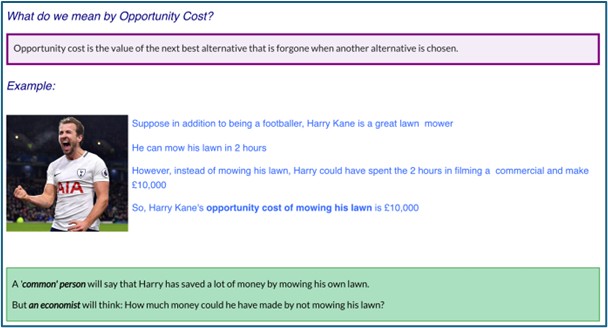
(2) For total and marginal product (of labour), we build examples on spreadsheets and plot the corresponding graphs:
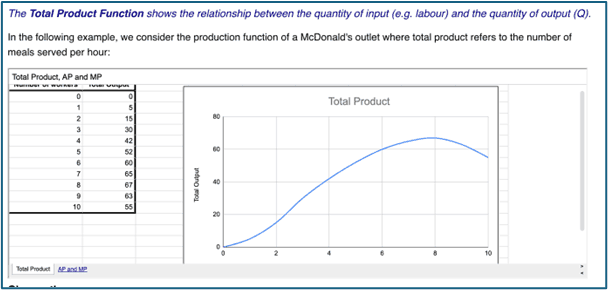
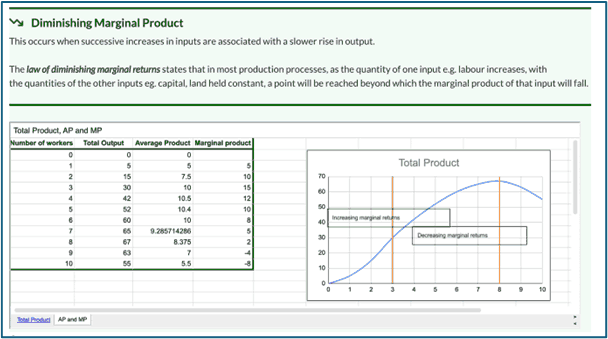
(3) For diminishing marginal utility, examples experienced in day-to-day activities are used:

Macroeconomics
In Macroeconomics we covered the concepts of real vs nominal variables, GDP and its various components, economic growth, unemployment, business cycles, inflation, money, government budget and debt, exchange rate, current and capital account, purchasing power parity (PPP) etc. The structure of the content was the same as in Microeconomics, but in some of the concepts we used data from sources and websites to acquaint students with the availability of the same. Wherever possible the data were embedded within the page such that students are able to navigate across countries and years. This will eventually be helpful for them in completing research projects in future years of study.
Some examples:
(1) GDP per capita demonstrated using data from Our World in Data. Embedding the link to the world map enables students to move the year line (at the bottom of the screen) to see the change in GDP per capita across the countries over the years.

(2) In net export, after the basic definitions, we demonstrated to students the intricate network of economic interactions across the world using an interactive visualisation of freight shipping created by the UCL Energy Institute and London-based data visualisation studio Kiln.
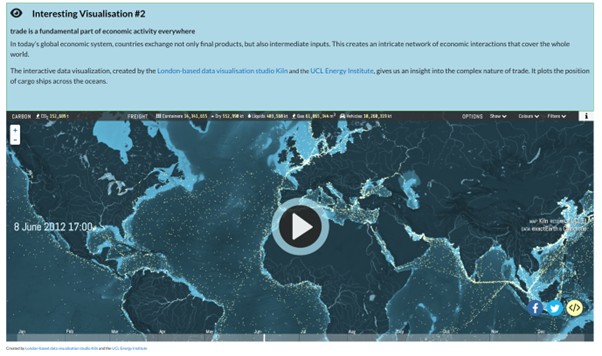
(3) While explaining some concepts, we introduced some interesting trivia to also make students aware of how forecasting is not an exact science and the world we predict may not turn out to be quite as we had thought it would be. For example, while discussing economic growth we delineated how after WWII, Germany and Japan were in shambles and that Saudi Arabia was tipped to be one of the fastest growing economies in the world in 2022.
(4) Some of the discussions were augmented with interesting readings from various sources, for example, under price index and inflation, we provided links to a couple of readings:

(5) Where possible we also introduced concept definitions from textbooks which would be used in modules. For example, the definition of unemployment was used from the CORE Economy textbook.
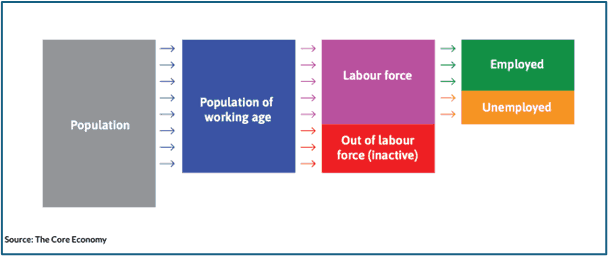
Under both Micro and Macro, the student collaborators created videos to explain the concepts in more detail. For example:


Other websites and podcasts
In addition to the sections on microeconomics and macroeconomics, we had a separate section where we enlisted some of the popular videos, podcasts and news sites, for example The Economic Lowdown Podcast Series and Video Series by the Economics Department of the St. Louis Fed for high school and college students and the The Sloman Economics News Site.
Student feedback
Students were very positive about the resource. They found the coverage to be quite comprehensive. Those who did not take A-level Economics thought it covered everything they needed to know to start their degree and that it served as a good baseline.
Furthermore, working on this resource enabled the student collaborators to develop communication skills through presenting and conveying key concepts in simple yet effective ways. The project contributed to honing their creative thinking and presentation skills as well as their IT (coding in HTML, designing quizzes in h5P) and cognitive skills.
References
Anderson, G., Benjamin, D., & Fuss, M. A. (1994). The Determinants of Success in University Introductory Economics Courses. The Journal of Economic Education, 25(2), 99–119. https://doi.org/10.2307/1183277
Birch, E. R. and Miller, P. W. (2007). ‘The Influence of Type of High School Attended on University Performance’, Australian Economic Papers, Vol. 1, pp. 1–17 https://doi.org/10.1111/j.1467-8454.2007.00302.x
Brasfield, D. W., Harrison, D. E., & McCoy, J. P. (1993). The Impact of High School Economics on the College Principles of Economics Course. The Journal of Economic Education, 24(2), 99–111. https://doi.org/10.1080/00220485.1993.10844784
Denny, E. (2014). 'Factors influencing the performance of non-economics majors in an introductory economics course' International Review of Economics Education, 17, 1-16. https://doi.org/10.1016/j.iree.2014.04.003
Happ, R., Zlatkin-Troitschanskaia, O. & Förster, M. How prior economic education influences beginning university students’ knowledge of economics. Empirical Research in Vocational Education and Training, 10, 5 (2018). https://doi.org/10.1186/s40461-018-0066-7
Jones, B., & Frydenberg, E. (2000). Coping with transition: A case for providing resources to first year university students. Australian Journal of Guidance and Counselling, 10(1), 81-94. https://doi.org/10.1017/S1037291100004
Mallik, G. & Lodewijks, J. (2010) Student performance in a large first year economics subject: which variables are significant? Economic Papers; 29(1); 80-86 https://doi.org/10.1111/j.1759-3441.2010.00051.x
Rach, S., Heinze, A. (2017). The Transition from School to University in Mathematics: Which Influence Do School-Related Variables Have? International Journal of Science and Mathematics Education, 15, 1343–1363. https://doi.org/10.1007/s10763-016-9744-8
Venezia, A., & Jaeger, L. (2013). Transitions from high school to college. The future of children, 117-136. https://doi.org/10.1353/foc.2013.0004
↑ Top
